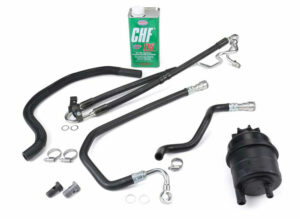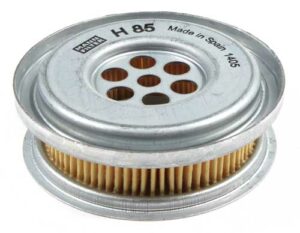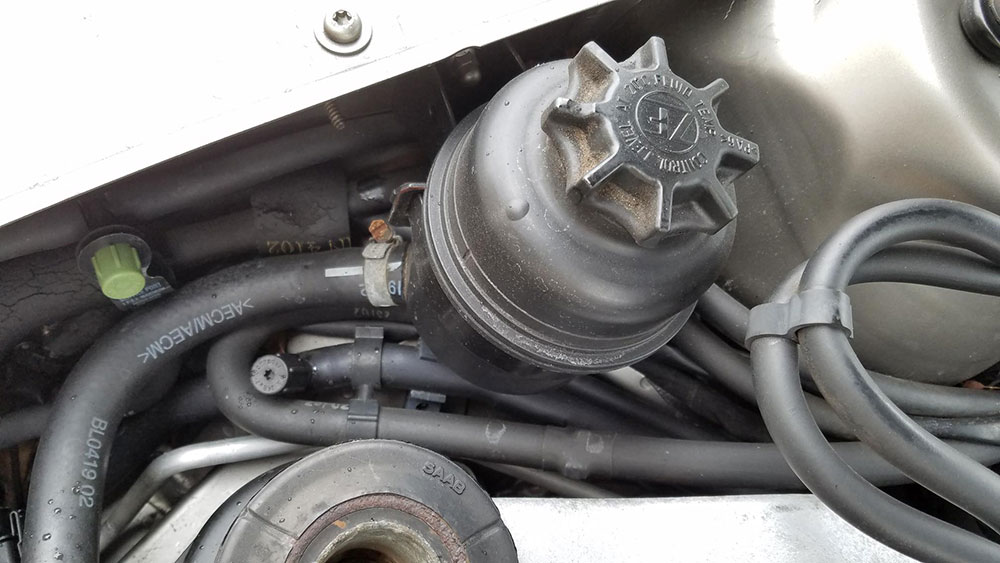The power steering system in your car is a high pressure, high stress, high heat environment. Like most systems in this situation, parts will eventually wear out. Good maintenance will help longevity, and luckily for you that only entails having the fluid flushed every so often. Changing power steering fluid can be a messy chore, but doing so every 35-50k miles will allow you to greatly extend the life of your power steering parts, which of course will reduce the frequency that you have to open the system up.
Choosing Power Steering Fluid
 Although most power steering fluid is very similar, having the right spec power steering fluid is pretty important. Whether you have an Audi, BMW, Mercedes-Benz, MINI, Porsche, Saab, Volkswagen, or Volvo, if you’ve never changed your PS fluid, now is a great time! Open your hood and take a look at the reservoir. In almost all cases, you will need to consult your manual to find what power steering is approved for your car.
Although most power steering fluid is very similar, having the right spec power steering fluid is pretty important. Whether you have an Audi, BMW, Mercedes-Benz, MINI, Porsche, Saab, Volkswagen, or Volvo, if you’ve never changed your PS fluid, now is a great time! Open your hood and take a look at the reservoir. In almost all cases, you will need to consult your manual to find what power steering is approved for your car.
If you’re lucky you will find the type of fluid to use is printed right on the cap. Common types of power steering fluid is the nearly ubiquitous CHF11s, as well as CHF202 used on some Volvo’s, and in some cases Dexron III ATF for some BMW’s. Power steering and ATF are sometimes interchangeable because they are both types of hydraulic oil, however always use the fluid outlined in your manual.
Why To Change Your Power Steering Fluid
The key components of the power steering involve heavily loaded gears (in the power steering pump and in power steering rack or box), and over time any oil will begin to shear. Shear happens when two surfaces cut against each other in two different directions, and this breaks down the oil and causes microscopic fragments of metal to be absorbed into the power steering fluid.
Pair that with high levels of heat and all sorts of gross stuff permeating hoses and the power steering reservoir/cap, and your PS fluid will get real nasty. I mean, hydraulic fluid by nature is nasty anyway, but if you’ve never changed your PS fluid before you will most likely find some sort of horrible black stinky sludge coming out of the lines. This causes power steering hoses to get porous and spongy and seals to go bad. Your precision components are not a fan of dirty sludgy oil, so keeping it fresh will greatly extend the life of your pump, rack/box, seals, and hoses.
If your hoses and seals are already leaky or degrading (most likely the case if you are here), it’s a great idea to replace everything at once and start with a fresh fill. That way you only have to do the job once and you can be done with a factory-like fill. We find most people change the pump and all the hoses together, and enjoy a refreshed system for years to come. It’s rarer to need to replace the steering rack, and that’s a blog for another day.
How to Change Your Power Steering Fluid
 Changing your fluid is pretty easy, although most power steering systems to not have a specific drain (look up the procedure for your car in case you do have a drain, although unlikely). Many professional auto shops have a machine that circulates the fresh fluid through much like an AC service. That’s the right way to do it, although many DIY’ers out there look to do this themselves to save money.
Changing your fluid is pretty easy, although most power steering systems to not have a specific drain (look up the procedure for your car in case you do have a drain, although unlikely). Many professional auto shops have a machine that circulates the fresh fluid through much like an AC service. That’s the right way to do it, although many DIY’ers out there look to do this themselves to save money.
To do a DIY flush, undo the bottom of one of the non-pressure hoses with the cap off, the fluid will pour out and generally get everywhere. One trick of the trade is to use a pair of clamps or locking pliers to pinch the hose to keep all of the fluid from rushing out. Make sure to put something between the rubber hose and the pliers to keep from creasing or tearing the hose (if you are not in the process of replacing them), shop rags work well. This will give you time to unplug the hose and move it over to a reservoir to collect the old power steering fluid.
Bleeding The Power Steering System
 With the wheels off the ground, reconnect the hose and top the fluid up, then start the engine. It’s a good idea to cap the reservoir when you start the car to keep any fluid from splashing out, but you will need to take it off for the next step. Move the steering wheel multiple times all the way left, to all the way right. This is called lock-to-lock. If you have a buddy do this step, you can observe the fluid in the reservoir as bubbles are released.
With the wheels off the ground, reconnect the hose and top the fluid up, then start the engine. It’s a good idea to cap the reservoir when you start the car to keep any fluid from splashing out, but you will need to take it off for the next step. Move the steering wheel multiple times all the way left, to all the way right. This is called lock-to-lock. If you have a buddy do this step, you can observe the fluid in the reservoir as bubbles are released.
If you do this with the wheels on the ground, you will put undo stress on the power steering pump during the bleeding process which can drastically shorten the life of the pump.
Once the reservoir is fully bled and the steering wheel feels good, you can either call it a day, or do it again. Because there is still a lot of the old fluid left in the system, it will take multiple tries to get most of the old fluid out. The subsequent drains you do will be a mix of old and new. Getting all of the fluid out will pretty much impossible, but even replacing 75% of the fluid with new will be a huge difference. Two or three drain and fills should get the job done for the average DIY’er.






I recently purchased a used Honda Pilot with about 140k on it- typical of the use- the fluid that came out looked just a bit short of tar- viscous and black- drained the reservoir with a suction pump and then added fresh fluid- as the article indicated- took about four of these suction and refill secessions to make a big difference- still some residue in the system but now the fluid is mostly clear- used the Honda factor fluid- figure since the manufacturer has specs better to trust their research and spend a bit more (got 6 pints on ebay for less than 1/2 the dealer parts counter price) and use the right stuff. The power steering is indeed a much neglected element- as is flushing the brake fluid (which I do once a year with LMA fluid) and flushing the cooling system (once every 50,000 miles). Have a couple of cars close to 300,000 with no brake system or cooling system problems- saved a lot of $$$$ over the years with simple preventative maintenance.
I like your style Steve